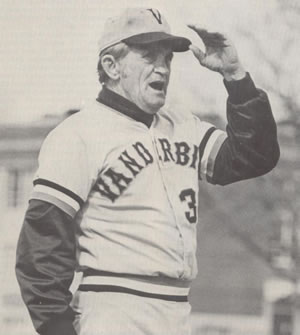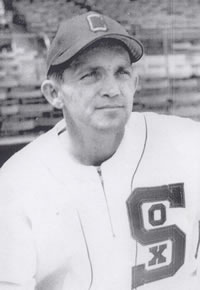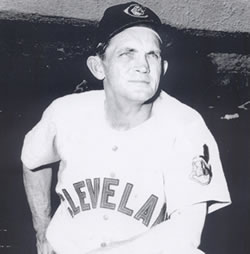May 16, 2007
CHC- Kerby Farrell Former Vandy Coach (pdf) | CHC Archive
Kerby Farrell is the only person from Leapwood, Tenn. (McNairy Co.) to have played baseball in a major league uniform. His life began in 1913 and he devoted 42 years to professional baseball. Farrell’s last season in the game he loved was at Vanderbilt in 1975 as a Commodore assistant coach to Larry Schmittou.
 |
|
| Kerby Farrell |
Gene Menees, former Vanderbilt and Sounds second baseman, was a senior in the year Farrell coached the Commodores. The season had started when Farrell joined the team with an 8-14 record while Menees was batting .235.
“I was not very big and I was pulling everything whether I was trying to or not,” Menees said recently. “Coach Kerby came in and set up an incentive plan. The incentive was for me to hit up the middle and to right field. He just basically got me to concentrate so much on hitting the ball up the middle to right field, which is the opposite way. It made me sit back and wait on the ball a little longer. It made me a much better hitter.”
Menees finished that season as an All-SEC member batting .301, second highest on the team. The Commodores were 8-14 when Farrell appeared early in the season. They finished, 30-29.
When Farrell passed away in 1975, F.M. Williams of The Tennessean wrote:
“Kerby Farrell was not the greatest baseball player to ever live, although Joe McCarthy once said he was the best fielding first baseman he had ever seen. He was not the best manager, either, although nobody else ever was voted Minor League Manager-of-the-Year three times as he was.
“But Kerby Farrell very easily might have been the greatest lover of baseball America has ever known, an epitaph his friends believe would please him more than anything else that could be said of him.”
Farrell graduated from Bethel Springs High School and attended Freed-Hardeman College (Henderson, Tenn.) where he played baseball and basketball. He began his professional baseball career in 1932 with Vicksburg of the Cotton States League as a first baseman. In 1933, Farrell led the Middle Atlantic League in fielding for a first baseman (.991). The following season he led the West Dixie League in runs (105) and first baseman in fielding (.991).
During the 1935-36 seasons, Farrell played for Memphis of the Southern Association, which would have brought him to Nashville’s Sulphur Dell ballpark for a battle with the hometown Vols. In 1941, he became a player-manager for Erie of the Middle Atlantic League (Class C). In two seasons as Erie’s skipper, he finished in second-place (75-51) and fourth-place (63-65).
In this era during World War II, major league rosters were diminished with many veteran players going into the service. Farrell was one of the players called upon by the Boston Braves of the National League to help fill their roster. In 1943, Farrell appeared in 85 games, batted .268 (75-for-280) with no home runs and 21 RBIs. His fielding average was .995. Casey Stengel was one of three Braves’ managers that season.
 |
|
In 1944, Farrell was back in the minor leagues with Indianapolis of the American Association. One year later he was back in the “Bigs” with the Chicago White Sox. Farrell appeared in 103 games, batted .258 (102-for-396) with no home runs and 34 RBIs. He fielded an average of .989 for White Sox manager Jimmy Dykes.
After the war, Farrell was back in the minors with Little Rock, Spartansburg (Tri-State League), Cedar Rapids (Three-I) and Reading (Eastern). From these years 1947-52, Farrell was again a player-manager. On July 21, 1946, playing first base for Little Rock, Farrell collected eight hits in a 19-inning game. Farrell’s last season as a player was with Reading in 1952.
While Farrell was managing Indianapolis (1956), the Triple-AAA farm club of the Cleveland, he learned that the Indians manager, Al Lopez had resigned. Since Farrell won four pennants in nine years in the tribe’s farm system, he knew that he would be a candidate for the vacant manager’s position.
Farrell was said about his candidacy:
“I went home (Henderson, Tenn.) after the season and I didn’t dare leave the house, expecting that important phone call. I missed all of Tennessee’s football games that fall and I couldn’t relax. Every time the phone rang I jumped.”
Farrell did get the call on Thanksgiving Day from Cleveland’s general manager Hank Greenberg who did offer the job. He accepted the position without discussing salary terms or length of the contract. Leo Durocher was first offered the job, but turned it down.
Cleveland finished Lopez’s last season in second-place (88-66) behind Stengel’s mighty Yankees. Farrell did inherit a team with great potential. In his starting rotation were Early Wynn, Bob Lemon and Herb Score all of which were 20-game winners. His lineup consisted of Vic Wertz, Rocky Colavito, Gene Woodling, Chico Carrasquel and rookie Roger Maris.
Things did not go well early on for Farrell’s 1957 Indians. Early in the season, he lost promising Score who had been Rookie-of-the-Year (1955) and an All-Star the previous two seasons. On May 7, 1957, Gil McDougald lined a pitch over the eye of Score who fell unconscious in a bloody scene. Farrell was one of the first to sprint to the mound to Score’s aid and at first, thought he was dead. Score’s career was never the same as he tried a partial comeback in 1958.
More misfortunes ensued as Wynn and Lemon developed sore arms. Wynn would finish the season at 14-17 while Lemon achieved a 6-11 mark. Considering the circumstances the Indians fell to sixth-place (eight-team league) with a respectable 76-77 record. Farrell was fired by Greenberg whom himself was also terminated by the club.
Farrell said for years that the Score incident cost baseball one of its greatest left-handers and cost him the best job he had. He went back to the minor leagues with Miami of the then International league. Farrell continued in the minor league system from 1959 to 1965 with Buffalo, Salinas and Williamsport.
Farrell was back in the major leagues in 1966-69 as a coach for Eddie Stanky’s White Sox. Stanky had been one of Farrell’s coaches in Cleveland. In his four seasons in Chicago, the White Sox finished fourth, fourth, ninth and eleventh. Farrell then found himself back in Cleveland for two years (1970-71) as a coach for manager Alvin Dark’s Cleveland Indians. The White Sox finished in fifth and sixth place in Farrell’s tenure as coach.
Now 58 years old, Farrell was back in the minors with Lynchburg of the Carolina League as manager for the 1972 season. Farrell then became a scout for the Minnesota Twins and was out of baseball altogether in 1974. To stay active in baseball, he became the volunteer coach for Schmittou’s 1975 Commodores.
 |
|
George Leonard of the Nashville Banner wrote after Farrell’s death this story concerning a Vanderbilt baseball game:
“With two out and two on in the seventh inning of a game last April against strong South Alabama coached by Kerby’s long-time friend, Eddie Stanky. David Tyler of the Commodores smashed a drive to leftfield that became a hotly disputed home run. It was very close to being a ground-rule double actually. Tyler rounded second base, then hesitated, thinking the ball might have bounced over the fence and half expecting the plate umpire to change his original decision and rule it a two base hit.
“But Farrell, sizing up things immediately, waved Tyler on from his third base coach’s box, not letting him pause. He wasn’t about to let Tyler tempt fate. All that quick thinking did, very probably, was win the game. The home run–if it really was–left Vanderbilt trailing 7-6 and three more runs were scored in the next inning.”
Farrell was a pennant winner five times during his minor league managing career and his three Manager-of-the Year awards came in Indianapolis and Buffalo (twice). He died on December 17, 1975 in Nashville at age 62 just several months after being inducted into the Tennessee Sports Hall of Fame. Eddie Stanky was one of his pallbearers.
“We were grown men from an age prospective and when you sat around with a man like Kerby Farrell, you became a little boy.” said Menees. “We would sit around after games when we were on the road in restaurants and ask questions. He was in the major leagues when Ted Williams was playing. He told us that hands down Ted Williams was the best hitter he ever saw.
“The shift that they put on for Williams placed everybody on the right side of the infield. Coach Kerby said Williams could have hit to left filed, he was that good a hitter. But, Williams was so stubborn he wanted to prove that he could get hits though their shift. It was very interesting for a bunch of us that were 20, 21, and 22 years old. Coach Kerby had been at a level of baseball in the major leagues most of us grew up aspiring to be. We were almost like a little kid sitting around our grandfather telling old time stories.”
Traughber’s Tidbit: Vin Campbell (Cubs, 1908; Pirates, 1910-11; Boston Braves, 1912) was the first former Vanderbilt player to make it to the major leagues. In 1912, Campbell led the National League in at-bats (624) and outfielders with errors (24). Campbell signed a three-year contract in 1914 to play in the Federal League. The league folded in 1916 and Campbell never played again. In his six seasons, Campbell batted .310 in 546 games while clubbing 15 career home runs and drove in 167 RBI’s.
Next week read about Hall of Famer Tris Speaker playing on the Vanderbilt campus.
If you have any comments or suggestions you can contact Bill Traughber via e-mail at WLTraughber@aol.com.

